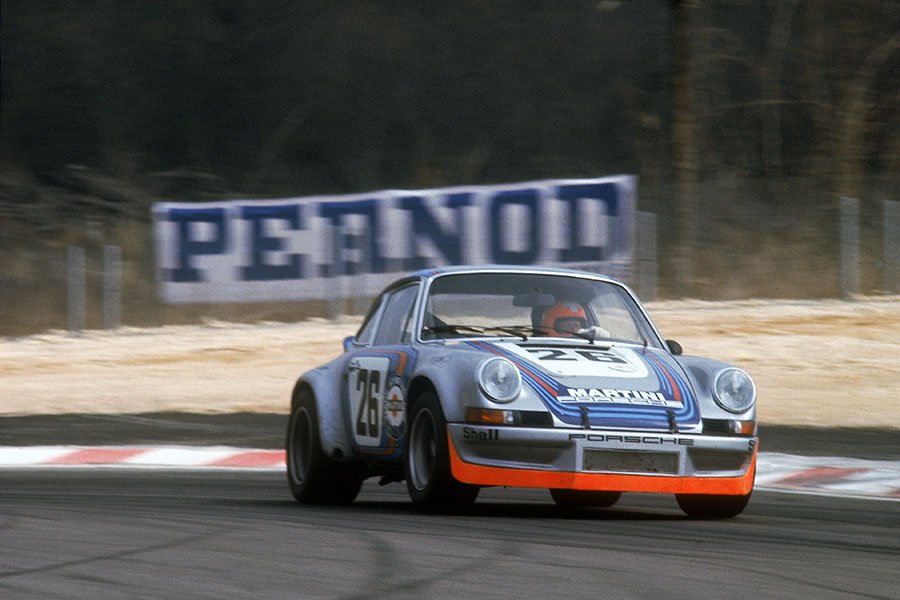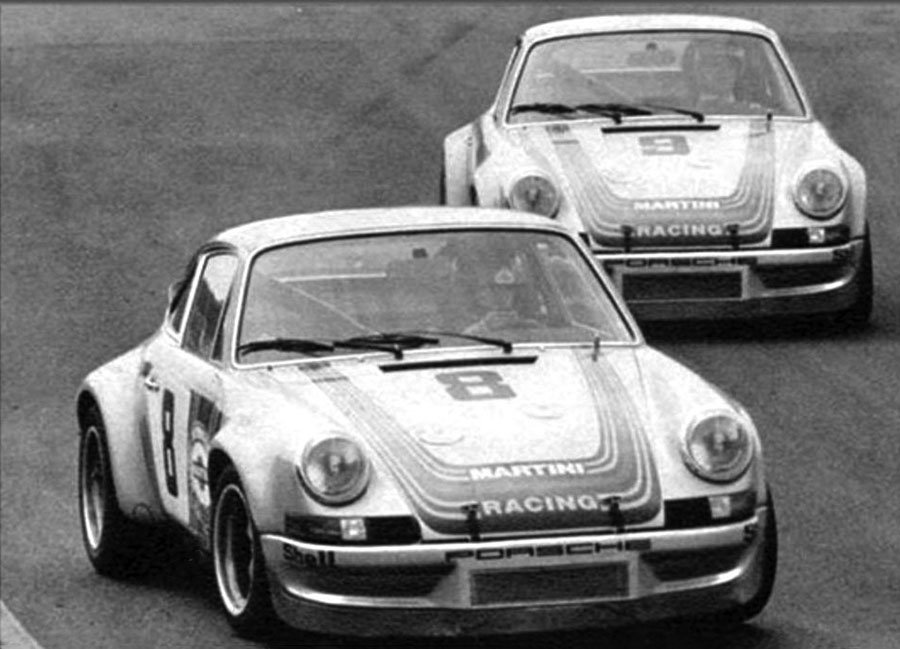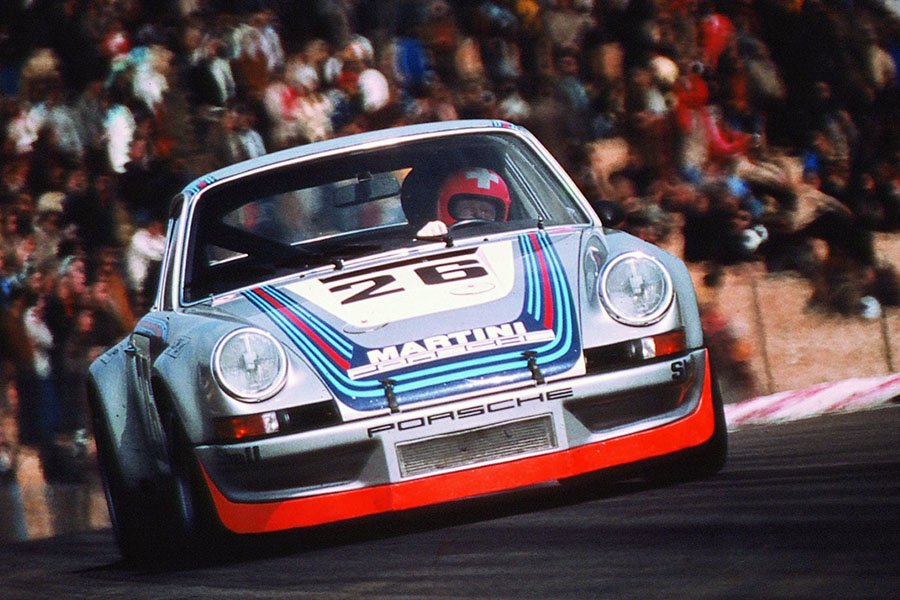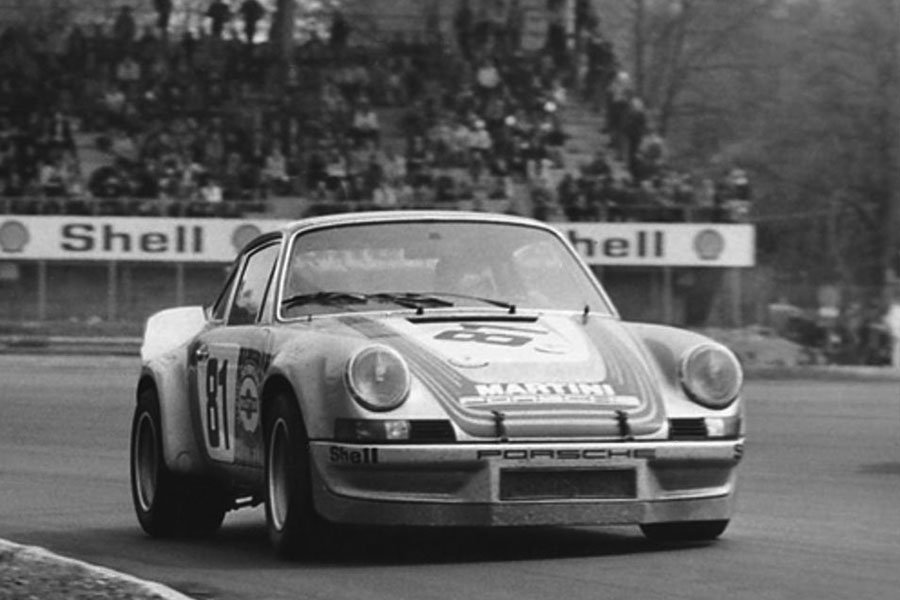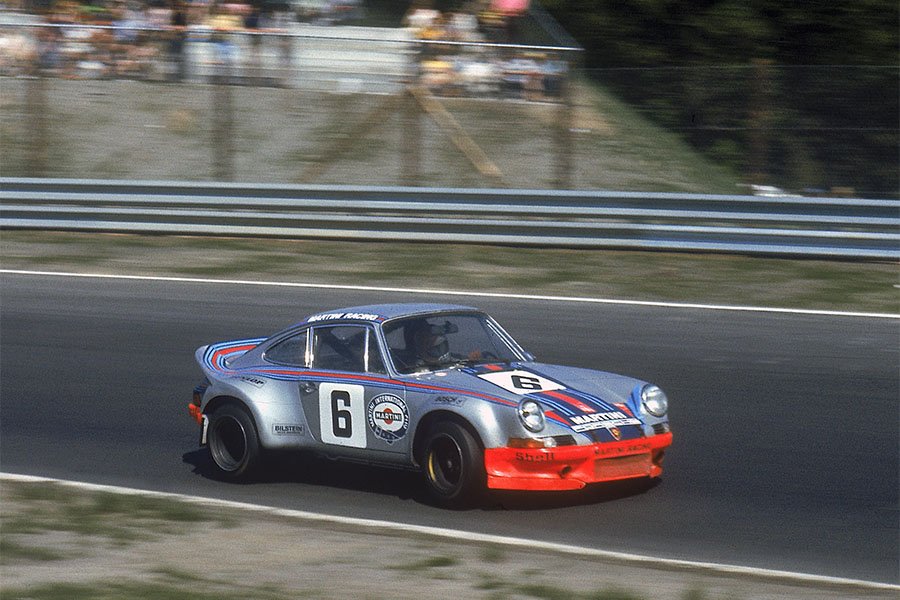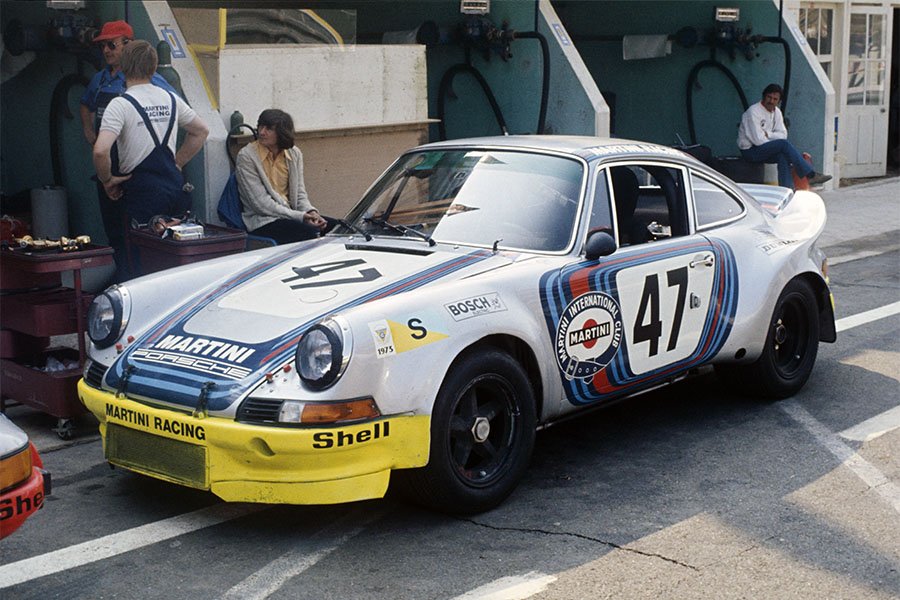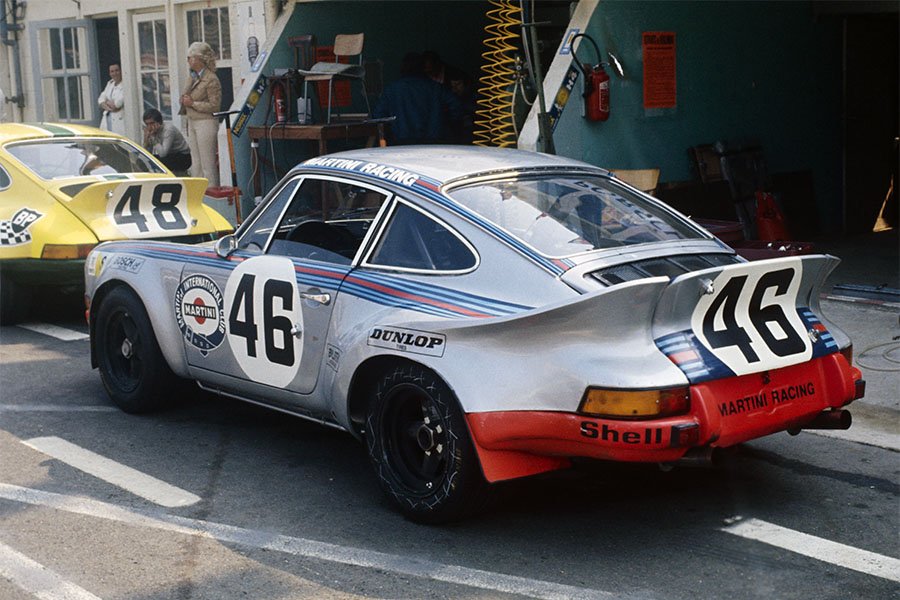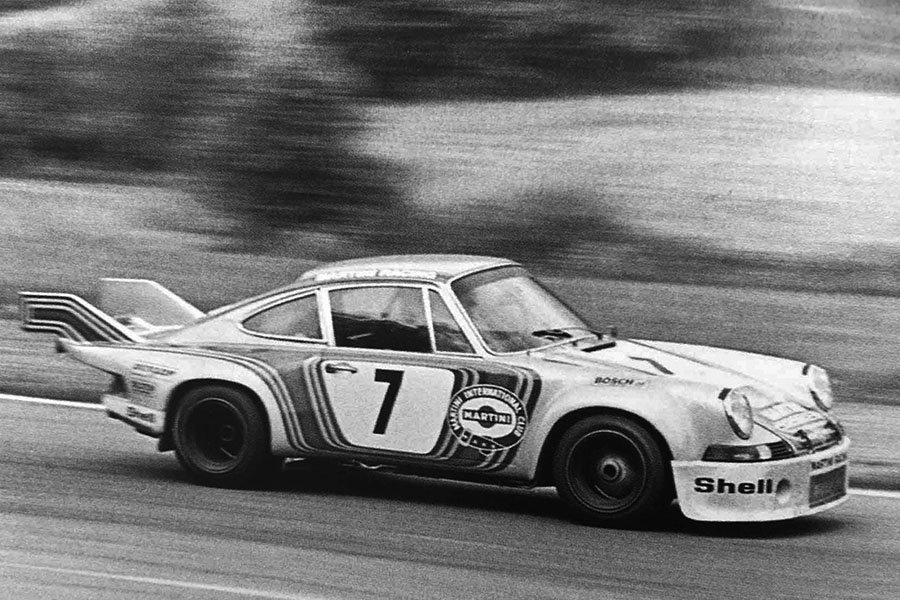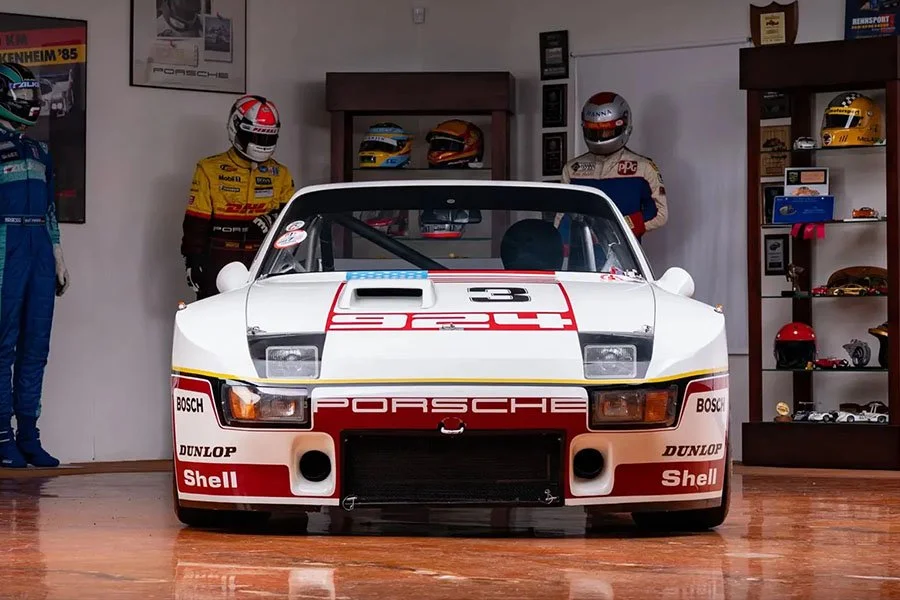Guide: Porsche 911 2.8 / 3.0 Carrera RSR / 73 Werks - a Historical & Technical Appraisal
/BACKGROUND
Having been appointed Porsche chairman in August 1972, Dr Ernst Fuhrmann immediately decided the 917 programme had become excessively expensive and too detached from the firm’s road car offerings.
Fuhrmann felt the company should re-focus its competition programme to vehicles that more closely aligned with those available in Porsche showrooms.
Accordingly, the 917 project would be wound down at the end of 1973; as a result, the new and astonishingly powerful 917/30 was given just one season in the limelight.
Thereafter, attention would turn exclusively to the 911 that, in motor sport terms, had always played second fiddle to the factory’s Sports Prototypes.
Since 1970, the premier category for production-based GT racing cars was Group 4. To qualify for Group 4, a manufacturer first had to produce 500 identical road-going base cars upon which a more extreme competition variant could be derived.
Porsche had already built small numbers of ST 911s for the Group 4 era, but works participation had been fleeting and limited to a handful of key events such as the Monte Carlo Rally and Tour de France.
As had been the case with the ST, Porsche could have used the standard road-going 911 to homologate a racing variant. However, to give the firm every chance of success, they conceived the fabled 2.7-litre Carrera RS homologation special which was launched at the Paris Motor Show in October 1972.
In turn, the 2.7 Carrera RS spawned a racing variant that was sold to customers: the 2.8 Carrera RSR.
Alongside the 2.8 Carrera RSR, which was available to anyone with sufficient funds, the works equipe (and a couple of Porsche’s trusted satellite teams in the USA) campaigned a small series of increasingly experimental RSRs designed to push the 911 concept to its absolute limit.
These tricked out factory specials gradually began to incorporate features not permitted on the 2.8 Carrera RSR which ultimately forced them into the Group 5 category for purpose-built Sports Prototypes such as those from Ferrari, Matra, Mirage and Alfa Romeo.
EARLY PROTOTYPES
The RSR story began with a pair of cars that the factory rebuilt with new bodyshells and re-numbered.
Chassis 9112300769 was originally delivered to privateer driver, Sobieslaw Zasada, for 1972. Zasada had only used the car in a couple of events before he crashed it heavily on the Polish Rally in July of that year. Zasada returned the car to Porsche and took delivery of a replacement. Meanwhile, the factory rebuilt 9112300769 around a new shell and re-numbered it as 9113600001 (‘0001’).
Chassis 9112300841 was an unused bodyshell that the factory renumbered as 9113600002 (‘0002’).
These two cars subsequently served as development mules for the forthcoming Carrera RSR.
1972 ZELTWEG 1000KM
As racing was the primary consideration, one of the prototypes was quickly wheeled out to assess its capabilities on track.
In late June, 0002 was trucked to Austria for the Zeltweg 1000km (the penultimate round of that year’s World Sportscar Championship).
The Indian Red car was allocated to factory drivers, Gunter Steckkonig and Bjorn Waldegaard. To avoid attracting too much attention it was discretely entered under the auspices of long-standing Porsche customer, Paul Ernst Strahle.
As the car had not yet been homologated into Group 4, 0002 had to run in the three-litre Group 5 Sports category. However, this enabled Porsche to try out several experimental features of the type that would be adopted for 1973.
Listed in the race entry as a 911 S 2.7, chassis 0002 was fitted with an engine said to be “somewhere between 2.7 and 3-litres” and with an output of “around 290bhp”.
Other special equipment included the same cross-drilled and ventilated anti-lock brakes introduced on the Martini 917 of Helmut Marko / Gerard Larrousse at the same race a year earlier.
The front suspension had also been modified and the rear wheels were widened to 11-inches (up from 9-inches on the ‘72 911 ST).
Externally, 0002 stood out on account of its custom front apron, flared fenders and a distinctive boxed-in Ducktail rear spoiler which also incorporated an adjustable trailing flap.
0002 qualified 18th on the grid, one place ahead of the fastest bona fide Group 4 GT entry: the 5.7-litre V8-powered De Tomaso Pantera Gr.4 of Alex Janda and Hans Schulze-Schwering.
In the race, 0002 proved significantly quicker than the 285bhp Kremer Racing 911 ST of John Fitzpatrick and Erwin Kremer. Steckkonig and Waldegaard ultimately claimed tenth place overall and finished ten laps clear of their closest GT class contender.
FURTHER DEVELOPMENT
After the Zeltweg race, 0002 returned to Germany where, alongside 0001, it resumed its role as a development mule.
In early November 1972, Porsche completed the first brace of their special R-numbered RSRs: 9113600019 (also known as R1) and 9113600020 (R2). They were subsequently followed by another six R-numbered examples that would be campaigned throughout 1973 (R3 through R8).
These tricked out factory specials were continually developed during the ‘73 season and equipped with all the latest competition parts from the Weissach racing department.
CHASSIS
Each RSR was built on a unitary steel bodyshell without any rustproofing or sound deadening material. Like the RS, a lightweight floorpan was fitted and the suspension mounts were reinforced.
Additional upgrades fitted to the RSR included solid drivetrain mountings and a front strut brace.
As ususal, suspension was via torsion bars and telescopic shocks. The front end used a compact MacPherson strut arrangement with a single lower wishbone. At the rear, semi-trailing arms were installed.
Compared to the RS, the RSR was enhanced with any array of new parts to include stiffer Bilstein dampers and thicker adjustable anti-roll bars. Hard plastic bushings were used for many of the suspension mounts. A needle-type bearing design was adopted for the front axle control arm and the rear axle strut connection.
To alter the rear trailing arm’s axis of rotation and keep the contact patch of the tyres as flat as possible, the rear axle link was shortened and the pivot point on the cross tube was moved backwards.
The brake system was also suitably uprated, most notably with cross drilled and ventilated discs and finned four-piston calipers imported from the 917. Brake balance was fully adjustable.
To reduce the dynamic radial variation during dive under braking, the steering knuckle of the front axle was moved upwards on the damper tube.
To achieve an improved adhesion between the hub and rim when braking, Porsche fitted reinforced hubs with a larger diameter plus five-screwed driving pins and a central nut with a larger friction surface.
Dunlop shod 15-inch diameter Fuchs alloy wheels of 9 and 11-inches were used (up from 6 and 7-inches respectively). Also present were wheel hub spacers and larger wheel bearings.
Customers could choose from one of five different fuel cells for their RSR. A 62-litre steel tank or 85-litre plastic tank both retained the standard fuel filler cap on the left-hand front fender. Plastic tanks of 100 or 110-litres, or the expensive FIA spec. 120-litre tank, all came with a quick fuel filler cap mounted in a front lid cutaway.
The two battery boxes housed in the front fenders could be removed to improve brake cooling. When this option was taken up, a single battery was mounted in the concealed smuggler’s box.
ENGINE / TRANSMISSION
Three different engines were used by the factory during the 1973 season. Each was developed out of the Type 911/83 motor fitted to the RS base car and was a dry-sumped, air-cooled, all-alloy Flat 6 with single overhead camshaft valve gear.
First to arrive was the Type 911/72 power unit which, thanks to a 2mm bore increase (92mm instead of 90mm), displaced 2806cc as opposed to 2687cc (a gain of 119cc). Stroke length was kept at 70.4mm.
The 2mm bore increase was made possible thanks to cylinder heads that were further apart and Nikasil cylinder linings with aluminium rather than magnesium castings. New forged pistons enabled the compression ratio to be hiked from 8.5:1 to 10.3:1. The connecting rods were specially balanced.
In addition, the RSR motor featured a huge array of hot parts to include four bearing racing camshafts with uprated housings, throttle bodies with intake funnels, rocker arms without adjusting screws, Marelli (later Bosch) twin plug ignition, bigger inlet and exhaust valves, ported cylinder heads, ST valve timing, new Bosch mechanical fuel-injection with an uprated space cam to increase fuel flow, a smaller engine fan and a dual pipe straight through competition exhaust system.
The original magnesium alloy crankcase was replaced by a heavier but stronger item fashioned from Silumin alloy.
The crankshaft was imported from the RS albeit lightened, crack-tested and polished and with a new crankshaft damper.
Peak output was 308bhp at 8000rpm and 217lb-ft at 6200rpm.
For comparison, the 2.7 RS pumped out 210bhp at 6300rpm and 188lb-ft at 5100rpm.
By April of 1973, Porsche had developed a three-litre Type 911/74 motor that had been bored out by an additional 3mm (to 95mm) which gave a displacement of 2993cc. Power output was now 315bhp.
For the Le Mans 24 Hours in June, an even more highly tuned Type 911/75 motor was on stream with 330bhp.
The existing five-speed 915 gearbox was always retained, albeit now with its own oil cooler and an additional pump for pressure lubrication. There was also a lightweight flywheel and a steel disc clutch spring instead of a rubber torsion damper. An uprated limited-slip differential with 80% locking factor was fitted as standard.
BODYWORK
Like the 2.7 RS, the RSR came with body panels that were considerably lighter than on series production 911s.
Thinner steel was used for the front and rear wings, the front lid and the roof. The engine cover was fibreglass and featured an integrated Ducktail spoiler. Below was a single piece fibreglass bumper.
A fibreglass single piece apron was also fitted up front and came with a large rectangular intake to feed an oil cooler. A chin spoiler was soon added as well.
All four wheelarches were more dramatically flared than on the RS.
Rubber retaining straps were added to the front lid.
Like the M471 Sport-optioned RS, thin Glaverbel glass was installed. The rear quarter windows did not open.
‘Carrera’ decals were adhered down each flank and a matching ‘Porsche’ script was added across the engine lid.
INTERIOR
The RSR’s cockpit was based on that of the M491-optioned RS Sport.
Fabric Recaro buckets were fitted – the driver got a proper racing seat with a six-point harness while the simple passenger-side item was imported from the RS Sport. A fire extinguisher and roll cage were fitted as standard.
Thin black felt was glued in place instead of proper carpet and there was a simple black headliner.
Door trim panels were the same basic type fitted to the RS Sport and the windows were manually operated.
There were no rear seats and to save even more weight the clock and passenger-side sun visor were absent.
Instrumentation comprised a 10,000rpm tachometer mounted centrally flanked to the right by a 300kph speedometer (both of which were unique to the RSR). Off to the left were combined read outs for oil pressure / oil temperature and fuel / oil level.
WEIGHT / PERFORMANCE
The first RSRs weighed in at the homologated 900kg. However, by the end of the season this had come down to around 830kg thanks to the use of titaniuam and fibreglass parts.
Depending on gear ratios, 0-62mph could be hit in a little over 4 seconds. With the tallest ratio installed, a top speed in excess of 180mph was possible.
1972 TOUR DE CORSE
Ahead of the ‘73 season, a series of tests were carried out at Paul Ricard. Chassis R1 and R2 were also wheeled out for a preparatory outing on the 1972 Tour de Corse. At this stage, the suspension was still to more or less RS specification.
The 687km Tour de Corse was round 23 of the 1972 European Rally Championship. It took place over November 4th and 5th and comprised 24 stages, all of which were on tarmac.
R1 arrived in Corsica with a 2.8-litre engine and was allocated to Bjorn Waldegaard / Hans Thorszelius.
R2 had a 3-litre engine and was used by Gerard Larrousse / Christian Delferier.
For this event, both were finished in a white and red striped Marlboro livery and appeared under a Porsche KG entry.
Significantly, the 1972 Tour de Corse marked the debut for Lancia’s prototype Stratos (which was similarly backed by Marlboro). Also in attendance was the works Alpine Renault team with no less than five A110 1800s.
Unfortunately, neither Porsche made it to the end: Larrousse went out with transmission failure while Waldegard crashed out having set a blistering early pace.
Victory went to the works Alpine A110 of Jean-Claude Andruet and Michele Espinosi-Petit who led from start to finish.
1973 SEASON
Porsche retained 0001, 0002, R1 and R2 for the 1973 season. New cars numbered R3 through R8 were also built up.
The un-raced 0001 continued to act as a test mule prior to being sold off in February ‘74 (by which time it was surplus to requirements).
0002 (as raced at Zeltweg) was rebuilt as a Martini team car then used for promotion and development purposes. It was also drafted in to compete at one event (the ‘73 Targa Florio) after another RSR (chassis R8) was destroyed in practice.
R1 did not appear again following Waldegaard’s accident on the ‘72 Tour de Corse but was used for testing.
R2 was also used for R&D and then rebuilt as a Martini team car for 1973.
Group 4 homologation was approved on March 1st.
European legs of the 1973 World Sportscar Championship would be managed by the works Martini Racing team while, in the USA, that responsibility fell to Brumos and Penske Racing.
1973 DAYTONA 24 HOURS
The 1973 World Sportscar Championship kicked off with the Daytona 24 Hours that took place over the weekend of February 3rd and 4th.
A pair of the new works-supported RSRs were in attendance: R3 was entered for Mark Donohue / George Follmer and appeared in a dark blue and yellow livery (the colours of Penske Racing’s sponsor, the Sun Oil Company). R4 was on hand for Peter Gregg / Hurley Haywood and was painted in the Brumos colours of white with thick red and blue stripes.
As the RSR had not yet been homologated into the Group 4 GT category, both cars ran in the Group 5 Prototype class where they would be up against Gulf-backed M6 Mirages, a lone Matra MS670, Scuderia Filipinetti’s Gitanes-backed Lola T282 and a couple of old Porsche 908s. Unfortunately, a lack of prize money meant Ferrari stayed at home with their latest iteration of the 312 PB.
Gregg / Haywood qualified eighth in the Brumos RSR and Donohue / Follmer lined up twelfth in their Penske machine.
Although Donohue had to make an unscheduled stop to address an out-of-balance wheel, both cars ran strongly in the early stages with the Brumos machine fifth and the Penske entry sixth.
The first of the more highly fancied entries to drop out was the much delayed Bell / Ganley Mirage which disappeared after 179 laps with clutch trouble.
Shortly after the five hour mark, the Matra of Cevert / Beltoise took lead from the Hailwood / Watson Mirage which came in for a clutch change. At the same time, the Joest Porsche 908/03 of Joest / Casoni (which should have been promoted to second) came in for a 90 minute stop to rectify a leaking fuel tank.
This meant the two 911s suddenly found themselves in second and third, twelve laps behind the Matra which was being very steadily driven at around same pace as the Porsches.
Later in the evening, Donohue briefly moved the Penske RSR into second while Haywood was black flagged in the Brumos entry for a faulty headlight. However, when the Penske car came in for fuel, the Brumos 911 re-took second spot. At this stage (around one third distance), the two Porsches were nine laps behind the Matra which had made a leisurely stop for fresh tyres and brake pads.
It looked like Matra had the race pretty much sewn up, but shortly after midnight, Francois Cevert rolled to a halt with a connecting rod sticking out the side of the block. This left Penske and Brumos holding the first two positions in the so far faultless Carreras. Third placed Arturo Merzario was 18 laps behind in his Group 4 Ferrari 365 GTB/4C.
By this time, the Bell / Ganley Mirage had been retired following a second clutch repair which meant the team’s hopes rested with Hailwood / Watson. The Joest 908/03 was also out with gearbox issues.
At around 5am, the Penske machine pitted with a three-quarter lap lead over Brumos, but soon after it rejoined an ominous trail of smoke began to emerge. The blue Porsche was quickly brought back into the pits where it was diagnosed with a holed piston and retired.
By 9am, the 53 car field that started the race was down to just 17 runners. R4 had by this time developed a large crack in its windscreen, however, with a 35 lap lead, the eight minute stop to fit new glass proved inconsequential.
Peter Gregg and Hurley Haywood ultimately went on to win by 22 laps.
After its historic victory, R4 was retired from competition duty. Penske sold R3 to Al Holbert who used it to contest the 1973 Trans-Am series.
Brumos went on to race a customer RSR in the IMSA and Trans-Am series for the rest of 1973 (chassis 9113600727).
1973 MARTINI PRESS CONFERENCE
On March 5th, Martini Racing held its annual Press Conference at the Pavilion d’Armenonville in the Bois de Boulogne. The event, hosted by Count Rossi, marked the announcement of ex-John Wyer Automotive Engineering manager, David Yorke, as team boss.
Resplendent in its new Martini colour scheme, chassis 0002 was presented alongside one of the team’s 917s from 1971. A two-car programme was announced for the European legs of the ‘73 World Championship.
1973 VALLELUNGA 6 HOURS
Round two of the 1973 World Sportscar Championship was the Vallelunga 6 Hours on March 25th.
As expected, Martini Racing arrived with two works-supported cars: chassis R5 for Gijs van Lennep / Hebert Muller and R6 for George Follmer / Willi Kauhsen. With Group 4 homologation having been approved, both cars ran in the GT class which meant they did not have the benefit of some of the improved suspension and engine parts seen at Daytona.
The Martini squad would be up against very limited opposition in the shape of a solitary customer RSR run by Porsche Club Romand, a pair of Panteras and a Porsche 914/6.
None of the works drivers were particularly happy with the way the cars were handling, but new uprights and other suspension upgrades were in the pipeline once these parts had been homologated on April 1st.
A timing error saw van Lennep / Muller given a bogus qualifying time which meant it lined up in 15th having supposedly gone nearly six seconds quicker than Follmer / Kauhsen who started 21st. The only other GT class car to qualify was the customer RSR of Cheneviere / Zbinden in 20th.
While the customer RSR retired shortly before mid distance with a faulty clutch pedal, the Martini cars had a race long battle with one another. This was eventually decided in favour of Follmer / Kauhsen when the van Lennep / Muller entry had to make a last minute stop to change a front tyre which let the sister car through.
Follmer / Kauhsen finished seventh overall and van Lennep / Muller were eighth. As the only GT cars still running, Martini Racing claimed first and second in class.
Outright victory went to the Mastra MS670B of Pescarolo / Larrousse / Cevert.
1973 LE MANS TEST
Next up for Martini Racing was the annual Le Mans Test which took place over the weekend of March 31st / April 1st.
The two factory Porsches went extremely well with Muller posting fourth fastest time in R6 and van Lennep going fifth quickest in R2. Both cars ran in the Group 5 category as they arrived with several as-yet un-homologated parts. Impressively, Muller’s best lap was over seven seconds quicker than the Greder Racing Team Chevrolet Corvette that had topped the Grand Touring category.
The Matra MS670B of Beltoise / Larrousse went fastest overall. Ferrari were prevented from attending owing to a strike at the factory.
1973 LE MANS 4 HOURS
In an attempt to attract participants to the test and help justify opening the track, the Le Mans governing body organised a four hour race for Sunday afternoon.
Not all the teams that attended the test took part; the fastest car in qualifying had been the Archambaud Racing Lola T292 of Larrousse / Bayard, but as a result of subsequent engine trouble it had to start at the back of the field.
This left van Lennep / Muller on pole in R2 while Manfred Schurti / Helmuth Koiningg were just behind in R6.
Both Martini Porsches were overtaken by the fast-starting Lola during the early stages of the race and van Lennep had a good battle with Henri Greder’s Corvette until both cars pitted for a driver change. Soon afterwards the engine in the Larrousse / Bayard Lola overheated and it was pushed into retirement.
Muller thus inherited a lead he would retain until then end. R2 took the win from the Touroul / Rouget Porsche 910 while Andruet / Wollek secured the final podium spot in their Pozzi Ferrari 365 GTB/4C. Schurti / Koinigg took fourth after a steady run in R6.
1973 DIJON 1000KM
Martini Racing returned to World Sportscar Championship action with a single car entry for van Lennep / Muller the Dijon 1000km on April 15th (chassis R5).
Three other GT cars completed the small but high quality entry: a pair of customer RSRs from Kremer and Porsche Club Romand plus a De Tomaso Pantera from Ecurie Franco Britannic.
Unlike the customer versions, R5 appeared at Dijon with modified suspension to include titanium springs plus a newly homologated trailing link set up that helped keep all four wheels planted firmly on the ground.
In R5’s engine bay was rumoured to be a three-litre power unit, but Porsche were highly secretive on the subject. Kremer’s John Fitzpatrick claimed there was no way his car had the same motor as the Martini entry and this was born out in qualifying when R5 went 2.3 seconds quicker than the best customer RSR.
Muller / Van Lennep started from 15th, Cheneviere / Zbinden were 16th for Porsche Club Romand, Fitzpatrick / Keller lined up 18th for Kremer and the Pantera qualified 19th.
In the race, the only trouble for the Martini car was an unscheduled rear tyre change after excessive oversteer had worn it flat. Muller / van Lennep finished three laps ahead of the Kremer RSR in ninth overall.
Pescarolo / Larrousse took the outright win for Matra ahead of the Ickx / Redman Ferrari.
1973 MONZA 1000KM
Ten days later, round four of the World Championship took place with a 1000km race at Monza (April 25th).
After suspicions at Dijon, Porsche confirmed both their cars in attendance were running engines that had been bored out to three-litres. They also featured the same rear suspension upgrades used in France which was a point of consternation for one of the Italian competitors who claimed the changes in question had not been homologated.
The organisers ultimately decided to put the Martini Porsches in the Group 5 Prototype class and they were forced to re-qualify on the second day of practice.
As a result, the Martini crew decided to take advantage of the unrestricted modifcations permitted in Group 5 and hurriedly riveted additional aluminium spoiler panels in place either side of the original Ducktail. These extra winglets subsequently became known as Mary Stuart collars.
The two cars taken to Italy were R6 for van Lennep / Muller and R8 for Follmer / Schurti.
Follmer / Schurti qualified fastest of the production-based cars in 24th while van Lennep / Muller lined up 34th.
Unfortunately, neither of the Martini entries finished the race. Follmer was an early retirement after just 19 laps when he brought R8 into the pits having over-revved the engine during a missed gear change. The sister car of van Lennep / Muller went out on the 62nd of 174 laps with a blown piston.
Victory in the Group 5 class went to the Ferrari 312 PB of Ickx / Redman and the GT category was won by the customer RSR of Schickentanz / Kremer which finished eighth overall.
1973 SPA 1000KM
Round five of the ‘73 World Sportscar Championship was the Spa 1000km which took place on May 6th.
Martini Racing took two cars to Belgium: R5 was entered for the Group 4 GT category and originally allocated to van Lennep / Muller while the big-winged R6 would run in the Group 5 Prototype class for Follmer / Joest.
However, mid-way through practice, Muller and van Lennep decided they wanted to race the Group 5 car which meant Follmer / Joest were relegated to the Group 4 entry.
An unhappy Follmer did subsequently manage to get R5 round with third quickest time in the GT class (20th overall – behind a pair of Kremer customer RSRs), but he said the car’s handling scared him to death.
Muller and van Lennep qualified 13th in the Group 5 Martini entry and had a solid run to finish fifth overall. The M6 Mirages of Bell / Hailwood and Hailwood / Ganley finished first and second followed by the Matra MS670B of Pescarolo / Larrousse / Amon.
In the Group 4 category, Fommer and Joest took a lucky win after the Schickentanz / Fitzpatrick customer RSR went out with a blown engine just before the end. Follmer had actually been leading the GT class when he handed over to Joest, but the German driver proceed to lose nine seconds per lap which meant Follmer was third when he got back in for his second stint. The Martini car had looked to have no chance of a win until Kremer’s lead RSR blew up.
1973 TARGA FLORIO
May 13th saw the final running of the Targa Florio at World Sportscar Championship level. In future, the epic contest which took place around a spectacular 72km Sicilian road course was deemed too unsafe for the World Championship organisers.
Martini Racing took four cars to Italy in the hope of scoring a major upset on a track that was arguably better suited to the 911 than top flight Prototype racing cars. All of the Martini 911s ran in the Group 5 class with the latest pistons installed. Also running in the same category was a Marlboro-backed works Stratos prototype.
R6 was allocated to the number one pairing of Muller / van Lennep, R2 to Leo Kinnunen / Claude Haldi and R8 to Gunther Steckkonig / Giulio Pucci. Chassis 0002 went along as a spare in the event of any mishaps around the unforgiving circuit.
Just such an incident occurred during the Friday evening practice session when Pucci lost it in a big way at the top of Campofelice and slammed sideways into a tree. Fortunately, the impact was on the passenger side of the car, otherwise Pucci would almost certainly have been killed.
With its bodyshell crumpled beyond repair, R8 was written off.
In its place, 0002 was hastily prepared which included the installation of R8’s engine.
Muller / van Lennep went fifth quickest in practice behind the 312 PB Ferraris and 33/TT/3 Alfa Romeos. The Stratos of Munari / Andruet posted sixth quickest time while Steckkonig / Pucci had gone eighth quickest and Kinnunen / Haldi 15th. One of the two Group 5 Alfas failed to start after the car driven by Clay Regazzoni somersaulted down the mountainside and landed upside down in a field, miraculously without injury to the driver.
The race got underway shortly after 9am with cars sent off in 30 second intervals.
At the end of lap one, Muller was fourth behind the two Ferraris and sole remaining Alfa. However, lap two saw the Ferraris of Merzario and Ickx drop out with transmission failure and crash damage respectively. At this point, it looked like Alfa Romeo had the race in the bag if Stommelen and de Adamich could keep their car on the road.
However, after Stommelen handed over to de Adamich at the end of lap three, a local driver in a Lancia Fulvia failed to see the fast approaching Alfa and forced it off the tarmac. With his suspension too deranged to continue, de Adamich was faced with a long walk back to the pits.
This left Muller and van Lennep at the head of the field with a decent-sized gap over the Stratos which had been delayed by stops for attention to a broken seat.
The Porsche drivers completed the remaining 500km at a steady pace to win by a little over six minutes from the Lancia. Kinnunen / Haldi were another twelve minutes down the road in third and Steckkonig / Pucci claimed sixth following a couple of minor delays.
1973 NURBURGRING 1000KM
Martini Racing reverted to a two-car entry for Porsche’s home race: the Nurburgring 1000km on May 27th (round seven).
On this occasion, chassis R7 was entered for Muller / van Lennep to contest the Group 5 class while R5 ran in the Group 4 category with Follmer / Kauhsen.
R7 was a brand new RSR with a re-shaped back end designed to take massive new centre-lock wheels with titanium hubs. The rear wheels went up to 15-inches wide while the fronts came in at 10.5-inches. Thanks to an all-fibreglass body, R7 was now considerably lighter than a Group 4 RSR.
Muller / van Lennep put R7 15th on the grid while Follmer / Kauhsen lined up 16th. However, R5’s lap was widely thought to be the result of a timing error as it went over eleven seconds quicker than the next best GT car (a customer RSR run by Kremer).
The 44 lap race got underway at 11am. Gijs van Lennep initially dropped behind a series of Group 2 saloon cars but had managed to repass them all by lap three.
Meanwhile, Follmer had established a healthy GT class lead in R5, but his race ended abruptly on lap seven when the car suddenly went sideways without warning at the Adenau Bridge. R5 planted itself firmly into the barrier and sustained quite serious damage to the chassis.
By this time, van Lennep had moved R7 into seventh.
Subsequent retirements for the de Adamich / Stommelen Alfa Romeo 33/TT/12 and the Cevert / Beltoise Matra MS670B saw the RSR rise to fifth by the time the chequered flag fell.
Victory went to the Ferrari 312 PB of Ickx / Redman with the sister car of Pace / Merzario second.
1973 LE MANS 24 HOURS
Undoubtedly the biggest sports car race of 1973 was the Le Mans 24 Hours which took place over the weekend of June 9th and 10th. For this event, round eight of the World Championship, there were three factory RSRs on hand.
One was the lightweight wide-bodied R7 (for Muller / van Lennep) as raced at the Nurburgring two weeks earlier. Chassis R6 (for Joest / Haldi) arrived at la Sarthe in a similar configuration to R7 having been comprehensively uprated since its last appearance (when it won the Targa Florio). Both cars ran in the Group 5 class with new 12-inch rears wheels and the latest 330bhp Type 911/75 engines.
The other works-assisted RSR was chassis R2 which contested the Group 4 Grand Touring category. This yellow and green car appeared under a Porsche Sonauto BP Racing banner for Peter Gregg / Guy Chasseuil. Sonauto was Porsche’s French distributor.
Muller / van Lennep qualified 18th with the sister car of Joest / Haldi just behind in 19th.
The Group 4 entry of Gregg / Chasseuil started from 36th which was second fastest of the under three-litre GT cars behind the customer RSR of Loos / Barth (which started 32nd).
A 4pm rolling start saw most of the field blast away without incident. However, Joest’s Group 5 RSR seemed to be making very slow progress and R6 was brought into the pits at the end of its opening tour for attention to the gearbox.
At the three hour mark, van Lennep was in a battle for seventh position with the two-litre Group 5 Chevron B23 of Pierre Maublanc. Joest had got the sister Martini car back up to 30th following its lengthy stop while Peter Gregg had moved the yellow and green Sonauto entry up to 15th.
By midnight, the 55 car field was much depleted. The Martini RSR of Muller / van Lennep was going like a train in eighth and the Sonauto machine of Gregg / Chasseuil had moved into eleventh. Unfortunately, the other Martini entry of Joest / Haldi had retired shortly before 10pm owing to a broken fuel system.
At mid-distance (4am) things were looking good for the two remaining factory 911s with Muller / van Lennep now up to fifth and Gregg / Chasseuil just three places behind in eighth.
The Sonauto Porsche’s progress was delayed between 5am and 6am after it picked up a puncture on the Mulsanne Straight which caused some damage to the front suspension and brakes. Up until this point it had been battling with one of the NART Ferrari 365 GTB/4Cs and a Kremer customer RSR for the class lead. Chassis R2 rejoined the race down in 15th position.
Thereafter, the sole Martini picked up just one position; R7 moved into fourth shortly after 9am and held station until the chequered flag. The Sonauto machine did run as high as twelfth, but had dropped back to 14th at the end. This was nevertheless good enough for third in the three-litre GT category while the Martini machine was fourth in the three-litre Group 5 class.
Victory went to the Matra MS670B of Pesarolo / Larrousse with the sister car of Jabouille / Jaussaud third. The runner up spot went to Merzario / Pace in a Ferrari 312 PB.
1973 ZELTWEG 1000KM
The penultimate World Championship event of 1973 (round nine) was the Zeltweg 1000km on June 24th.
Since Le Mans, Porsche had developed a revised rear body section with a large faired-in spoiler that extended well beyond the rear bumper and featured two vertical stabilising fins. A new flat front apron had also been created.
R6 arrived in Austria with this new arrangement (for van Lennep / Muller) while R7 (for Koinigg / Schurti) adopted the new flat-face front apron but was otherwise in the same trim seen at Le Mans two weeks prior.
Neither Muller or van Lennep had even tested the new bodywork before heading to Austria and first practice took place in extremely wet conditions. Somewhat inevitably, Muller went off while navigating the flat-out right hander at the end of the main straight; a deep patch of water sent the Porsche spinning along the barrier, denting the front and back ends of the car around wheel height.
Fortunately, the new tail was untouched and the damage was not too serious. R6 was repaired overnight and qualified tenth during the dry second session. The sister car of Koinigg / Schurti lined up twelfth.
Both cars ran like clockwork in what proved an uneventful race for Porsche. They quickly moved up to seventh (Muller / van Lennep) and eighth (Koinigg / Schurti) but both cars had dropped down a position by the chequered flag as the Scuderia Bresica Corse Alfa 33/TT/3 of Pasotti / Facetti made up for lost time.
At the sharp end, Pescarolo / Larrousse took another win for Matra.
1973 WATKINS GLEN 6 HOURS
Round ten of the ‘73 World Sportscar Championship and the season finale played out with a six hour race at Watkins Glen on July 21st.
Following the Zeltweg contest, Muller and van Lennep had stayed on for two additional days of testing at the Austrian track, during which time the long tail RSR’s two vertical stabilising fins had been connected with an adjustable central plane which much improved handling and downforce.
Both R6 and R7 arrived in the US sporting this latest bodywork; R6 would run in the blue and yellow Penske colours (for Donohue / Follmer) while R7 appeared in the white, red and blue livery of Brumos (for Gregg / Haywood).
Also in attendance was chassis R3 which Al Holbert had been campaigning in the Trans-Am series. Still in its original blue and yellow colour scheme, Holbert would share his privately owned car with John McComb.
R3 ran in the GT class while R6 and R7 contested the three-litre Prototype category.
The two Group 5 cars qualified tenth (Penske) and eleventh (Brumos) while Holbert’s machine was 19th (fourth quickest of the Group 4 machinery).
Holbert / McComb retired from proceedings at two thirds distance with suspension trouble.
By contrast, the Group 5 pairing moved up to sixth and seventh off the line and continued to run reliably throughout the race. Gregg got ahead of Donohue on lap three and the two cars proceeded to run nose to tail seemingly in a race of their own.
This latest until quarter distance when Gregg limped into the pits with a broken driveshaft which took ten minutes to fix. Meanwhile, Donohue’s Penske RSR ran like clockwork and even began to harry a couple of the purpose-built Group 5 Prototpes.
Chassis R6 ultimately came home in sixth behind the race-winning Matra of Larrousse / Pescarolo, a brace of Ferraris and the two Mirages.
After its ten minute delay, the Brumos RSR also ran reliably to claim seventh, ten laps behind its long tailed sister car.
1973 WATKINS GLEN CAN-AM
The next day (July 22nd), Watkins Glen hosted a 60 lap Can-Am race (round three of the 1973 series). Rounds one and two had been won by the Porsche 917/10s of Charlie Kemp and George Follmer as Mark Donohue’s much-fancied 917/30 had experienced trouble of one kind or another.
Chassis R7 was the only GT-style car entered for the Watkins Glen Can-Am race which comprised two 30 lap heats with the winner decided on aggregate. Against a field of super lightweight Group 7 cars, Peter Gregg managed to out-qualify a couple of two-year old privateer McLaren M8Fs to line up 19th on the 21 car grid. He went on to finish a creditable ninth overall as Mark Donohue stormed to a maiden victory in his Penske 917/30.
1973 TRANS-AM CHAMPIONSHIP
Following its retirement after a strong showing at Daytona back in February, Roger Penske had sold chassis R3 to Porsche dealer Al Holbert who ran the car in the 1973 Trans-Am Championship under the Holbert’s Porsche-Audi Inc. banner.
For 1973, the Trans-Am series comprised six races ranging in distance from just under 200 miles to just over 300 miles.
Holbert’s chief opposition came in the shape of Peter Gregg who ran a tricked out customer RSR that incorporated several parts from his Daytona winning example.
Holbert finished as runner up to Gregg at the season-opening Road Atlanta 500 and was third at Lime Rock for round two. He then teamed up with Mark Donohue for round three at Watkins Glen, but they finished a distant eighth.
The final three rounds saw Holbert pick up a fourth at Sanair, third at Road America and fourth in the season-ending Edmonton event where he shared R3 with Milt Minter. However, although R3 was classified fourth at Edmonton, the car met a spectacular end when Minter crashed on the third turn of the final lap. R3 barrel rolled and landed on its roof in what was a major accident.
Fortunately, Milt Minter was released after a few days in hospital with neck and back injuries.
The same could not be said of R3 which Al Holbert had to rebuild around the bodyshell of a 911 T for the 1974 season.
Al Holbert finished his 1973 Trans-Am campaign as runner up to Peter Gregg with 49 points compared to 56.
Text copyright: Supercar Nostalgia
Photo copyright: Supercar Nostalgia & Porsche - https://www.porsche.com
